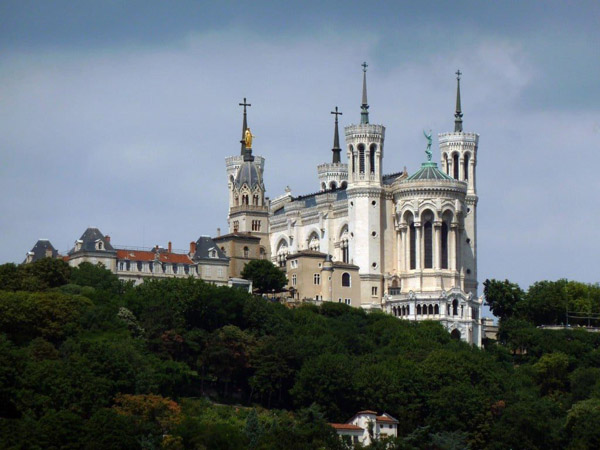
In this series, condensed from a book written by Fr. Northcote prior to 1868 on various famous Sanctuaries of Our Lady, the author succeeds in defending the honor of Our Blessed Mother and the truth of the Catholic Faith against the wily criticism of many Protestants.

The traveler who has been induced either by curiosity or devotion to ascend the steep hill which rises in the midst of the city of Lyon will hardly fail to carry away with him impressions not easily effaced. Standing on the terrace which overlooks the vast amphitheater below, he will perhaps recall with emotion the day when Pope Pius VII, from the same spot, gave his Apostolic Benediction to the city which but a while before had publicly celebrated its apostacy from Christianity by the most horrible acts of sacrilege, but whose inhabitants, on the 18th of April, 1805, were assembled in one kneeling mass at the foot of that hill to receive the blessing of the Vicar of Christ. Or he will remind himself of the tradition which associates the name of St. Thomas of Canterbury with that of Fourvière, and if he be of English blood will feel a pleasure in the thought that Notre-Dame-Saint-Thomas de Fourvière, as it was called, was the first sanctuary raised to the honor of the great English Martyr. Or it may be that glancing back yet further into the annals of the past, he will picture to his mind's eye the capital of Celtic Gaul as it stood in the days of its imperial splendor; when that same hill was covered with the vast forum of Trajan, with the palace of the Caesars, and the temple of Venus, the tutelary deity of ancient Lugdunum; and when St. Pothinus, the first apostle of Lyon, there made his glorious confession of the Faith, and the old man of ninety was kicked and trampled to death by an infuriated multitude shouting vengeance on the blasphemer of their gods.
But whatever may be the interest attaching to the Christian history of Lyon, it is not one of those spots which we visit only for the sake of its associations with the ancient past. It is a sanctuary where the Faith was seen surviving in all its active, living energy; where pilgrims still congregate, and miraculous graces were received, and where the Mother of God is still venerated in the heart of a great commercial city with all the ardor and simplicity of ancient times.
Lyon was always distinguished for its devotion to the Blessed Virgin, and a tradition, too well supported to admit of a reasonable doubt, points to the crypt under the Church of St. Nazaire as the sight of that subterranean oratory where St. Pothinus deposited the holy image of Our Lady which he had brought with him into Gaul. This crypt was the cradle of the Church of Lyon, a church which, next to that of Rome, may perhaps be said with most justice to have been cemented with the blood of martyrs. The Forum, whence so many thousands were dispatched to torture, or the Amphitheater, did not, however, long survive its bloody triumphs over Christianity. Septimus Severus reduced it to a heap of ashes, as a punishment for the adherence of the citizens to the cause of his rival Albinus, and removed the seat of government to Trier.
The hill covered with its marble ruins became known as the Forum Vetus, a title for which the
Lyonnaise Christians often substitute that of the Holy Mountain, or the Hill of Blood, but which appears
to have been the derivation of the modern name of Fourvière. And in the ninth century a modest chapel,
which was known as that of Our Lady of Good Counsel, was constructed out of the debris of the Roman buildings,
forming that quadrangular portion of the church which stands beneath the tower, and in the foundations of which
may still be detected several fragments of ancient marble. It did not at first attract any large share of popular notice.
The devotion of the Lyonnaise naturally enough clung rather to the crypt and the image of St. Pothinus; and in 1030
another sanctuary of Our Lady was erected by Abbot Hogier in the Ile-Sainte-Barbe, which bore the title of Notre Dame de Grâces.
This was regarded by the boatmen of the Saône as so holy a place that when they descended the river every crewman kept silence,
and every oar was raised; not a word was uttered as they floated down the current, save only that as they passed the towers
of the church the captain of each vessel mounted on his poop, and saluted the Holy Isle with the Celtic ejaculation of
Ben-hoia!
(Literally, Hail, wild duck!
from the supposed resemblance of the island, in form and position,
to that bird.)
The sanctuary of Notre Dame de Fourvière, erected on a soil which had been purpled with the blood of martyrs, was destined to owe her celebrity in the first instance to the honor with which she surrounded the memory of another more recent Martyr. The little chapel of Our Lady of Good Counsel had been made over by the Emperor Lothaire to the canons of the Cathedral Church of St. John, one of whom, named Oliver de Chavannes, commenced the construction of a long nave, which was added to the original building in 1168. Guichard, the Archbishop of Lyon, had been Abbot of Pontigny, four years before, when St. Thomas à Becket took refuge there from the persecution of Henry II. From his hands the English Primate had received the Cistercian cowl, which to the day of his death he never laid aside; and when Guichard was enthroned in his archiepiscopal city, St. Thomas, who regarded him as a personal friend, visited him there, a fact which is stated again and again in the ancient cathedral archives, though it has been overlooked by all English historians.
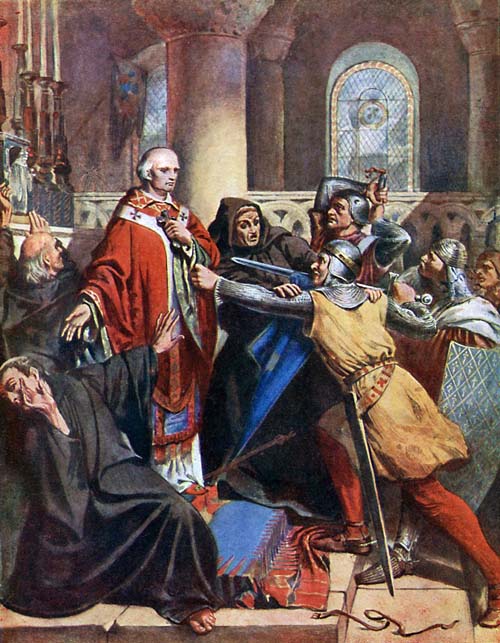 One day, it is said, Archbishop Guichard was walking on the Place St. Jean, in company with St. Thomas
and the canon, Oliver de Chavannes. The conversation turned on the buildings just commenced on the hill above them,
and St. Thomas, turning his eyes in that direction, inquired to whom the new sanctuary would be dedicated?
One day, it is said, Archbishop Guichard was walking on the Place St. Jean, in company with St. Thomas
and the canon, Oliver de Chavannes. The conversation turned on the buildings just commenced on the hill above them,
and St. Thomas, turning his eyes in that direction, inquired to whom the new sanctuary would be dedicated?
To the first Martyr who will shed his blood for the Church,
replied the Archbishop. Who knows if it may
not be yourself, if your enemies procure you such an honor?
The words were said perhaps between jest and earnest;
but, however that may have been, the metropolitan church of Lyon gave earnest tokens of her respect for the exiled
English Primate. She assigned him a house within the cloister, and the manor of Quincieu outside the city;
and gloried in enrolling his name among her canons. The prebend held by him was enjoyed by his successors until
the wars of the fourteenth century; and English monks resided up to that time at the manor-house of Quincieu.
Two years from the time when this conversation is supposed to have taken place, St. Thomas won his glorious crown of martyrdom, and the nave of Fourvière, on its completion, was dedicated by Guichard and Oliver to the memory of their illustrious friend, whose canonization took place in 1173, only three years after his assassination. It was natural enough that the memory of St. Thomas should be regarded with peculiar veneration in France, whose king and people had warmly espoused his cause during his lifetime, and given him generous hospitality for several years. A special grace received by Louis VII, as it was believed to be through the intercession of the Martyr, widely extended this devotion. His eldest son, afterwards Philip Augustus, being attacked with fever, and at the point of death, St. Thomas appeared to the king three times in a dream, promising him the cure of the young prince on condition that he himself should visit his shrine at Canterbury. In consequence of this, King Louis crossed over to England, and was escorted from Dover to Canterbury with great pomp by Henry II himself. After spending two days there watching and praying before the tomb, Louis made his offering of a splendid gold chalice, a magnificent diamond – which was afterwards worn on the finger of the sacrilegious plunderer Henry VIII – and the annual grant of a hundred measures of wine. He then returned to France, where, to his unspeakable joy, he was met by his son, restored to perfect health. His gratitude for this favor knew no bounds, and in testimony of it he dispatched additional offerings to the new sanctuary erected at Lyon in honor of the Saint, and, according to some writers, came to visit it in person.
For many years after this event, St. Thomas of Canterbury was regarded as more immediately the patron of the Church of Fourvière than our Blessed Lady; and it was on his feast, the 29th of December, that the chapter of the Cathedral paid their annual visit as feudal lords to their vassal church, on which occasion they celebrated Mass at the altar of the Saint, and not that of Our Lady. The canons of Fourvière, now erected into a collegiate church, in their turn paid their homage to the Cathedral on certain great festivals, and offered candles at the altars of St. John and St. Stephen, for in those times the feudal rights of superior churches were exacted with as rigorous a law as those of suzerain lords. At Easter a striking and picturesque custom preserved the memory of the tie which bound the two churches together. The count-canons of the Cathedral, as they were honorably designated, mounted the towers of their church, and the collegiate chapter of Fourvière assembled on the terrace overlooking the city: then the bells of both churches rang out, and the two choirs sang in alternate verses the Alleluia and the Paschal hymn O filii et filiæ.
As time went on the Church of Fourvière became regarded more and more as a sanctuary of Our Lady, and here, in 1466, Louis XI came in pilgrimage praying before the altar of Our Lady of Good Counsel, where he left orders that a Salve Regina should thenceforth be sung daily after a low Mass, which he endowed in perpetuity. In the act drawn up by this king, granting certain privileges to the canons of Notre-Dame-Saint-Thomas de Fourvière, the name of 'Monseigneur Saint Thomas' holds the secondary place, and it is evident that the primary devotion was beginning to be paid to the more ancient chapel of Our Lady.
The change is partly to be attributed to the fact that the other sanctuaries of Our Lady in Lyon
had lost somewhat of their former popularity. It is with devotion as with certain delicate plants which grow freely
in solitary and unfrequented places, but disappear before the footsteps of men. The crypt of St. Nazaire,
owing to the increase of the city, was now in the heart of a busy thoroughfare, and no longer enjoyed anything
of that retirement which seems required for a place of pilgrimage. The Holy Island of Ile-Sainte-Barbe had formerly
been revered by the Lyonnaise from the fact that it presented them with all the charms of religious solitude within
reach of their city walls. But time, alas! has little respect for such retreats, and, as years sped on,
the Ile-Sainte-Barbe was resorted to as a place of public amusement; and in fine weather, says one writer,
you might see all the citizens of Lyon flock there on holidays, with their wives and families, bringing with them
tambourine-players and other musicians; and the city trades would come here to exercise with their drums and banners;
the villagers from all the neighborhood round came hither, moreover, dancing and singing; and when one of the abbots
tried to close the meadows to the public, so as to put a stop to these revelings, the people rose en masse,
and pulled down his walls.
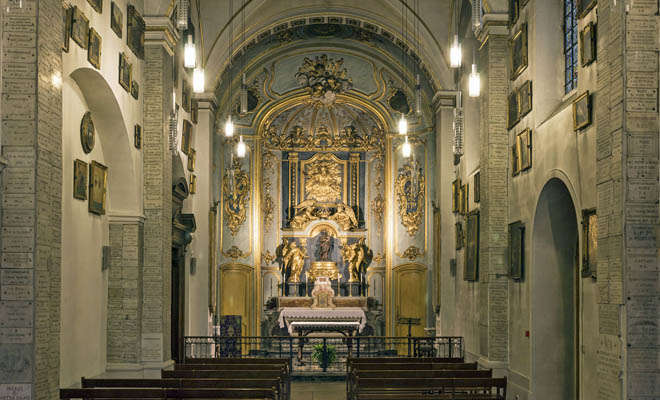
Chapel of the ancient image of Our Lady.
It was therefore no wonder that when so great a change had befallen the old sanctuaries of the Lyonnaise,
their devotion should turn into other channels; and the Holy Mountain of Fourvière, raised as it is above the noise and
tumult of the city, seemed to attract them thither by a natural instinct. We find therefore that during the terrible
famines of 1504, 1534 and 1556, when, according to the old chronicler Paradin, the earth seemed of fire,
and heavens of brass, when the flocks on the mountains all perished, and those on the plains were driven many leagues
to drink at the waters of the Rhone and the Saône, all smaller rivulets being dried up,
the White Procession,
as they were called, organized from all the country round to implore the mercy of God and the intercession of Our Lady
in this great distress, generally directed their steps up the barren slopes of the Holy Hill of Fourvière.
They came along, dressed in white sackcloth, bands of little children going first, barefoot and bareheaded,
singing and crying, with accents of genuine and heart-touching distress: Sire Dieu! Mercy! Holy Mary,
Mother of God, pray for us. Water! Water! Water!
What a cry was that! It drew tears, says Paradin, from the eyes of all who heard it, and it touched the Heart of the
Mother invoked with such child-like simplicity. The rain came at last, and that in such abundance that the vines were
restored as if by miracle. That year
continues the same writer, we ate ripe grapes on the feast of
St. John the Baptist; the other fruit-trees flowered in September, as if it had been spring, and in many places bore
fruit a second time. Apples were seen as big as tennis-balls; prunes and nuts also, but these last did not reach maturity.
This good, and, as it was believed, miraculous, season was granted to Lyon in 1556; the years that followed were years of sacrilege and profanation for Fourvière, which fell into the hands of a Calvinist mob, and was pillaged both of its riches, and, what was worse, of the Tabernacle and its Sacred Contents. Lyon became one of the great strongholds of the heretics, and most of its Catholic inhabitants found themselves forced to abandon the place. The pen refuses to chronicle the horrible deeds perpetrated by those who now found themselves masters of the city, and who celebrated their triumph by the destruction and desecration of her churches. The four walls alone were left of the nave of St. Thomas and the Chapel of Our Lady of Fourvière; and when at last better days dawned over France, and the ecclesiastics were able to re-enter the city of Lyon, the canons of Fourvière passed from the Place de la Providence up to the door of their collegiate church, over heaps of blackened ruins.
Owing to the poverty to which the canons were reduced by the late events, the restoration of the church was not completed before the year 1586, and during that time a new scourge, or rather a series of scourges, devastated Lyon, and made manifest to the world that, whatever else the Calvinists had laid in ruins, they had not succeeded in overthrowing the devotion of the people towards the Mother of God. Year after year the plague swept away its thousands of victims, one hundred thousand citizens in all having been said to have perished of this pestilence between the years 1564 and 1642. Deputations were sent by the magistrates with offerings to the shrines of Our Lady of Puy and Loreto, and on one of these occasions the plague stopped suddenly in the city, on the very day when the deputies entered the territory of Loreto. But it disappeared only to return again after a brief interval, until at last, in 1643, the magistrates solemnly determined to dedicate the city by vow to Our Lady of Fourvière. Ever since the restoration of that sanctuary its celebrity had been constantly on the increase, and the throng of worshipers and pilgrims became so great that twenty-five Masses were daily celebrated in the church, and two ecclesiastics were constantly engaged in receiving the offerings of the pilgrims. The veneration formerly paid there to St. Thomas had become almost forgotten, eclipsed by the fame of the graces dispensed by the Blessed Virgin from the sanctuary of Her choice. The vow of the Lyon magistrates expressed therefore the unanimous devotion of their fellow-citizens, and from the moment that it was registered, the plague not only disappeared to return no more, but from that time neither the cholera nor any other contagious malady has ever held its ground in Lyon.
In gratitude for this prompt answer to their prayers the city authorities bound themselves to visit Fourvière on the 8th of September every year, and to erect two images of the Blessed Virgin, one at the corner of the Place du Change, the other under a little dome in the middle of the Pont de Pierre, with an inscription recording the history of their vow. These two images remained as monuments of the devotion of the Lyonnaise to their great Patroness until the disastrous days of 1789, and the dome on the Pont de Pierre was still standing in 1820. But yet more unmistakable evidence was given of their fervent gratitude to Her whom they regarded as their deliverer, by the immense affluence of pilgrims who from this time flocked to pour out their vows before the holy sanctuaries. Even in 1630 these had been so numerous that the canons had to open a new door and erect another altar in their church, and three years later were forced to have recourse to the cathedral clergy to assist them in satisfying the devotion of the people. But from the hour that Lyon solemnly dedicated herself to the Blessed Virgin by the voice of her magistrates, the enthusiasm of the citizens took new life, and it must be added that their childlike confidence has from that time been rewarded by a continued stream of graces. Our limits will allow of our doing no more than to refer to these, for there yet remains to tell of another hour of desolation for the sanctuary of Fourvière, followed however, as before, by another resurrection.
Nowhere did the storm of the great revolution fall with greater violence than on the city of Lyon. On the 30th of August, 1792, the last Catholic Mass was celebrated at Fourvière, which was then abandoned for a time to some schismatic priests, and finally closed altogether. Meanwhile terrible scenes of sacrilege were enacted in the city. Paris had set up the goddess of Reason, but it remained for Lyon to witness her three revolutionary proconsuls, Collet d’Herbois, Fouché, and Laporte, offering divine honors to the ashes of one of their colleagues, the ferocious Chalier, who had fallen under an assassin's knife at the moment when he was about to deluge Lyon with the blood of her citizens. It was on the 10th of November, 1793, the very day when Paris consummated her great act of sacrilege in the Cathedral of Notre Dame, that the decree was published closing all the churches of Lyon. The reign of atheism was inaugurated by a hideous ceremony. The urn containing the ashes of Chalier was placed on an altar of turf erected in the Place des Terreaux. The three pro-consuls, surrounded by a crowd of ruffians and profligate women, who made the air ring with their cries of 'Vive la guillotine!', approached, and one by one bent their knee in adoration of the 'martyr of liberty.' Then followed an exhibition, the details of which would make the most indifferent shudder. An ass, decorated with the priestly insignia, was made to trample on the crucifix and the Book of the Gospels, and to drink out of a sacred chalice; and even yet more horrible profanities were in preparation, when they were put to a stop by what the miscreant themselves seem to have felt a preternatural sign of the Divine displeasure; the sky suddenly darkened, and such a terrible storm burst over the heads of the infamous assembly that with one accord they dispersed and fled from the spot in terror.
During the miserable years that followed, Our Lady of Fourvière was still invoked by those who remained faithful to the religion of their fathers, many of whom were accustomed to climb the holy hill by night and pray before the closed doors of the now desolate sanctuary for the return of better days. During the siege of Lyon by the revolutionary army, numbers performed this pilgrimage at the peril of their lives, and several extraordinary deliverances were accepted as tokens that Our Lady still retained Her watchful guard over the city. When at last the Reign of Terror ended, and a certain sort of religious toleration was permitted, two brothers, both of them ecclesiastics, opened a little school not far from the Church of Fourvière, and in their little house the faithful secretly assembled for worship.
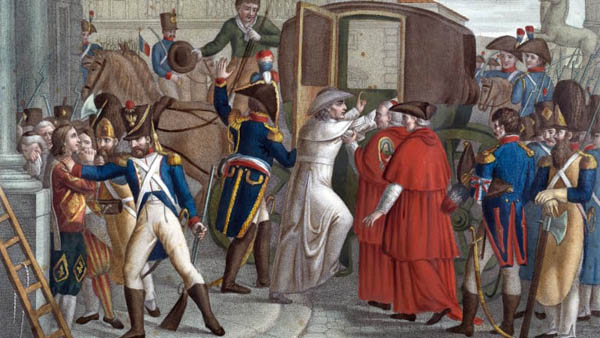
Pope Pius VII was eventually arrested by Napoleon.
The accession of Napoleon as First Consul was soon followed by the public restoration of the Catholic worship,
and one of the first acts of Cardinal Fesch, Archbishop of Lyon, was to repurchase the sanctuary of Fourvière.
And when, in 1805, Pope Pius VII was invited into France to preside at the coronation of the new Emperor,
he himself reopened the church, offered the Holy Sacrifice within its walls, and gave Holy Communion to 1,200 persons;
after which, as we have said, standing on the terrace which overlooks the city, he gave the Apostolic Benediction to the
kneeling population. No wonder that such a spectacle from such a spot drew from him the repeated exclamation of
Bello, bello! (Beautiful, beautiful!)
The scenes which met his eye during his progress through France
must have seemed to him like a rising from the dead, for as he himself expressed it, when speaking to Fouché,
He had traveled through a nation on its knees.
One other danger, however, still threatened Notre Dame de Fourvière. During the hundred days of Napoleon's
restoration, after his escape from Elba, it became a matter of importance to him to strengthen the defenses of Lyon,
and Marshal Suchet was dispatched thither, with orders, as it was believed, from his Imperial master,
to cover the holy mountain with fortifications. Such orders, if executed, would have implied the destruction of the
sanctuary of Fourvière; but Suchet was a Lyonnaise by birth, and had not entirely forgotten the religious impressions
of his childhood. He inspected the ground indeed, and made a survey of the city from the top of the tower,
but on descending thence, instead of announcing to the chaplains who awaited him in the sacristy his intention of
leveling the church to the ground, he addressed them in words which were little expected from the mouth of the
soldier of fortune. My mother often brought me here when a child,
he said, to pray before Our Lady's image.
It is pleasant to remember those days. Be so good as to take these Napoleons and say some Masses for my intention.
So saying, he laid some money on the table where the offerings were received, and, passing into the church,
remained for some time kneeling before Our Lady's altar. (Suchet's devotion to the Blessed Virgin had been evinced
during his campaign in Spain, when with equal resolution he refused to obey the order of Joseph Bonaparte for the plunder
of the Sanctuary of Our Lady of El Pilar. Nor did it pass without reward. He had the happiness of making a Christian end,
and received the consolations of religion before his death in 1826, a fact, unhappily, sufficiently rare among the public
men of that time, to be worthy of record.)
Fourvière was therefore spared, and during the next fifty years the devotion of the Lyonnaise to their
favorite sanctuary continued to increase. During the cholera years of 1832, 1835, and 1855, the exemption of the city
from this terrible pestilence has been acknowledged as a grace due to the intercession of Our Lady. Nor was Her protection
less remarkable during the political troubles of 1830 and 1848. In the latter year a bloody uprising was actually in
preparation, when extraordinary prayers and vows were offered to Notre Dame de Fourvière; and the storm blew over in so
singular and inexplicable a manner as to cause surprise to the revolutionary party themselves, one of who was heard to observe,
pointing to Our Lady's sanctuary, We shall do nothing here so long as that Montagnarde remains up there.
[It seems appropriate to mention here a few incidents from the life of Pauline Jaricot:
In July 1830, civil unrest became realized in the form of a local revolution of the workers of Lyon. Pauline went to the Shrine of Our Lady at Fourvière praying to become a martyr there in the church. But this was not to be her fate. As she had been fully expecting the grace of martyrdom, her first spiritual director, Abbe Wuerz, appeared to her in a vision and asked her if the "martyrdom of the heart" were not enough for her. During this period she constantly worked to help others. Even soldiers that threatened the city were benefactors of her good will. It is very interesting to note that during these periods of unrest, she got the inspiration to place above her doorways the phrase, "Mary was conceived without sin." There were many graces associated with this ejaculation. On one occasion (somewhat later) military troops were coming to seek vengeance on Lyon. Just before these troops were to enter the city, a pious woman went along the road and threw Miraculous Medals and little papers with the words, "Mary was conceived without sin." These objects, seen and picked up by the soldiers, calmed their hearts. The people of Lyon were praying that they would not be the victims of their vengeance. A great civil war was expected. However, on both sides, their hearts were found agreeable towards each other and an understanding between them came about. As a result, no battle was fought. Many soldiers requested medals from her and thousands were distributed among the troops. The inhabitants of Lyon considered this occurrence to be a miracle.
...Later there was more political unrest. This time, a civil war began. A battle was fought on Pauline's property. Wicked people, seeing the phrase, "Mary was conceived without sin," over the door of her residence, tried to break the door down. Begging Our Lady to preserve the city, this heroine called on her niece to run to the large tower in the city, which had a statue of Our Lady of Defense on the top. She asked her niece to place a sign on it. The sign read: "Our Lady of Defense, we implore Thy holy protection. Guard us, guard Lyon; obtain that today and all following days may be for the glory of Jesus and Thine. Oh Mary, conceived without sin, pray for us who have recourse to Thee."
As the fighting continued for several days, Pauline and eighteen of her companions first hid in the chapel of her home. Bullets and cannon balls flew; they even penetrated the house and whizzed over their heads. Fortunately, no one was hurt. This small group prayed without ceasing… Taking refuge in the nearby catacombs, the war raged for over five days with this band of holy souls never leaving the confines of that place during that time. However, through their sufferings, penance and prayers, peace was once again restored.
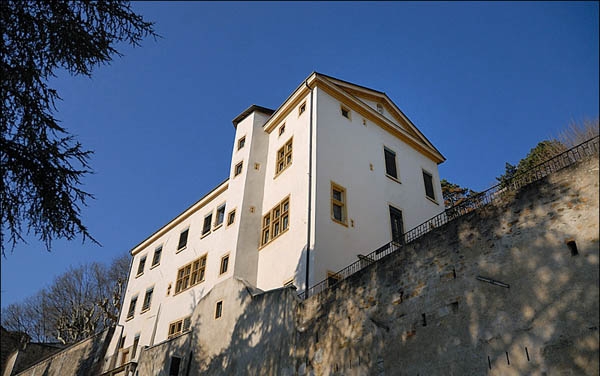
In 1832 Pauline bought a house in Fourvière, that she later called "Lorette" (image above), and founded a community of women called the "Daughters of Mary." This location in Fourvière became the headquarters for the Living Rosary. It is said that by the end of her life there were over two and a quarter million Living Rosary members in France alone.]
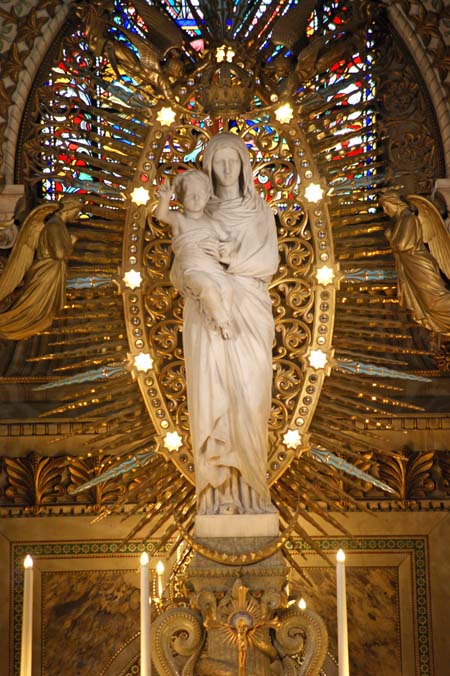 Perhaps, however, the most remarkable scenes were those witnessed at Notre Dame de Fourvière
during the insurrection which broke out in the city in 1834. The insurgents (again, mostly disgruntled workmen)
took possession of the hill, established their headquarters within the church, displayed a black flag from its tower,
and from their strong position exchanged a continuous fire with the troops. The chaplains of the sanctuary had been
obliged to withdraw before there was time either to remove the Blessed Sacrament or to conceal the sacred vessels;
but on the third day, the firing having somewhat subsided, what men had not the courage to do was effected by the
resolution of a nun – the Superioress of the Sisters of St. Joseph offered to mount the hill alone, and see what could
be done with the armed mob then in possession of the sanctuary. She presented herself before the workmen who were
assembled round a huge fire lighted on the church porch.
Perhaps, however, the most remarkable scenes were those witnessed at Notre Dame de Fourvière
during the insurrection which broke out in the city in 1834. The insurgents (again, mostly disgruntled workmen)
took possession of the hill, established their headquarters within the church, displayed a black flag from its tower,
and from their strong position exchanged a continuous fire with the troops. The chaplains of the sanctuary had been
obliged to withdraw before there was time either to remove the Blessed Sacrament or to conceal the sacred vessels;
but on the third day, the firing having somewhat subsided, what men had not the courage to do was effected by the
resolution of a nun – the Superioress of the Sisters of St. Joseph offered to mount the hill alone, and see what could
be done with the armed mob then in possession of the sanctuary. She presented herself before the workmen who were
assembled round a huge fire lighted on the church porch. My good friends,
she said, I see you are forced to take
shelter in the church; the presence of the Blessed Sacrament must embarrass you; shall I bring a priest to fetch it away?
Yes, that is a good thought,
replied the leader; we shall then be more at ease.
You will also give me
leave to enter the sacristy and put things a little to rights?
Yes, ma sœur, you may go and do what you like.
The brave religious lost no time in descending the hill and returning with two priests, and all three were allowed to enter the church. They found about twenty men and as many women, all of the lowest order, bivouacked in the nave, eating, drinking, cooking their meat at a large fire, drying their powder, and preparing fresh ammunition. But marvelous to say, the altars had not been touched. A barricade of chain had even been raised to wall of the sanctuary, and neither the tabernacle nor the image of Our Lady had received any profanation. The priests at once removed the Blessed Sacrament, and as they carried it out of the church, the sentinels gave the usual military salute, and some of them even followed as an escort, as far as the Providence, where it was deposited in safety. The good nun remained behind to take charge of the sacred vessels. She had brought a large sack with her into which she put every article of value she could carry, and what she could not carry she concealed in secure places. No one interfered with her or opposed her proceedings, and she was permitted to retire with her treasures, receiving every mark of respect as she passed through the ranks of the insurgents.
The next day the combat recommenced, and terminated in the triumph of the troops; and when the insurrection was over, everyone had something to say of the graces which had been obtained during those six terrible days, from Notre Dame de Fourvière. A number of workmen who took no part in the insurrection had retired to a large building known as the Maison Brunet. A shot which killed a lieutenant of the royal troops was falsely surmised to have been fired from this house, and without further inquiry a furious discharge of artillery was opened upon the house. The workmen, unarmed and defenseless, invoked Our Lady of Fourvière, and the firing stopped; for a priest had at that moment forced his way to the terrace then occupied by the king's troops, and persuaded them to spare the innocent. Not a man had been injured by the tremendous volley, and a few days later the victims who had thus so marvelously escaped destruction went in procession to Our Lady's altar to render thanks to their good Mother, and deposited as their ex-voto offering a picture representing the Maison Brunet at the moment of the cannonade.
The fact, however, that a few workmen had been able to hold the Holy Mountain for several days against a
royal army of 7,000 men, sufficiently proved its strength as a military post, and the old plan of converting it into a
fortified citadel was revived in good earnest. But this time the intentions of the Government were defeated by the piety
of the Lyonnaise. With one voice they protested against such a profanation, and petitions poured in, entreating that
nothing might be done to destroy the church of the Lyonnaise people.
They reminded the Government of July that
there was something even more precious than a fortress,
and that sacrificing the sanctuary of Notre Dame de Fourvière,
they would be striking a blow at the hearts of all Her votaries. Their earnestness prevailed, and Fourvière not only escaped
destruction, but its church was also restored and enlarged with greater splendor then ever.
The Lyonnaise conceived the plan of raising on the Hill of Martyrs a monument which shall at once commemorate Our Lady's Patronage of their city, and their own devotion. (At the time this article was written:) A new tower has already been completed, surmounted by a colossal image of Our Lady in gilded bronze, visible from every part of the city, over which She is represented as extending Her hands as if in benediction (image on front cover). The buildings which had formerly disfigured the side of the hill were cleared away, and in place of the former crude and fatiguing approach, a magnificent winding road has been cut, planted with trees, so as to form an easy and agreeable ascent.
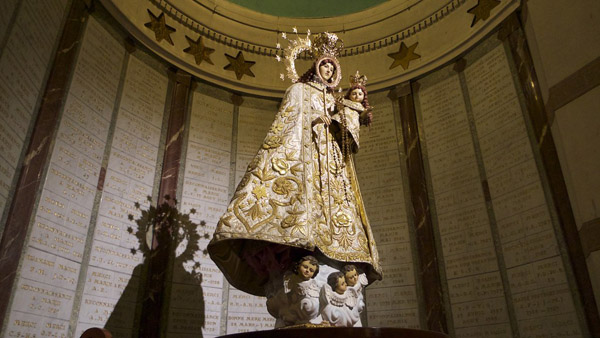
Sixteen thousand Masses are celebrated on an average during the year, and at least 200,000
Communions are annually made within the sanctuary. During the month of May alone, there have been as many as 27,000
Communions (note – this was well before St. Pius X permitted daily Communion), or something like a thousand a day;
and in spite of all the revolutions it has undergone, the walls of Notre Dame de Fourvière currently exhibit more than
4,000 ex-voto offerings. Elephant trappings sent from Egypt, and a Chinese picture from Peking, appear in the midst of a
forest of crutches, glittering in not a few places with crosses of the Legion of Honor, and spangled in every direction
with gold and silver hearts. Nor must we, in conclusion, fail to notice the last ornament presented to the sanctuary
by the piety of the Lyonnaise. In the enclosed space outside the church, fifteen small columns were raised in 1864,
on which appear representations of the fifteen Mysteries of the Holy Rosary, and the custom has established itself
for pilgrims to prepare themselves for their visit to Our lady by devoutly performing what is called
the stations of the Rosary.
On the Feast of Our Lady of Fourvière (celebrated in the Diocese of Lyon on January 22),
it is a common thing for surrounding parishes to come hither in procession with their own curés at their head,
and Fourvière still remembers with veneration the pilgrimage made here by the holy Curé of Ars (St. Jean Marie Vianney)
and his people. (The Pilgrimage to Fourvière,
says M. Monin, in his Life of the Curé d'Ars (tom. 1, p. 229),
marked the precise epoch of the religious transformation of the parish.
) Such facts have their own significance;
they prove that, to use the words of Pope Pius VII, France was still preserving her Faith, and the the City of Martyrs,
as it has been termed by one of its own Saints, has done well in protesting to an infidel government that the Faith of a
generous people is a surer protection against the assaults of revolution, than the garrison of half a million bayonets.
NEW: Alphabetical Index
Contact us: smr@salvemariaregina.info
Visit also: www.marienfried.com